Mental Health Issues in Contemporary Society
VerifiedAdded on 2023/05/30
|14
|3848
|298
AI Summary
This article discusses the increase in mental health issues in contemporary society due to pressure, stress, and societal expectations. It suggests prevention measures and policies to tackle mental disorders. The article also explores different perspectives on mental health, including psychiatry, psychoanalysis, and psychology. Course code, course name, and college/university are not mentioned.
Contribute Materials
Your contribution can guide someone’s learning journey. Share your
documents today.
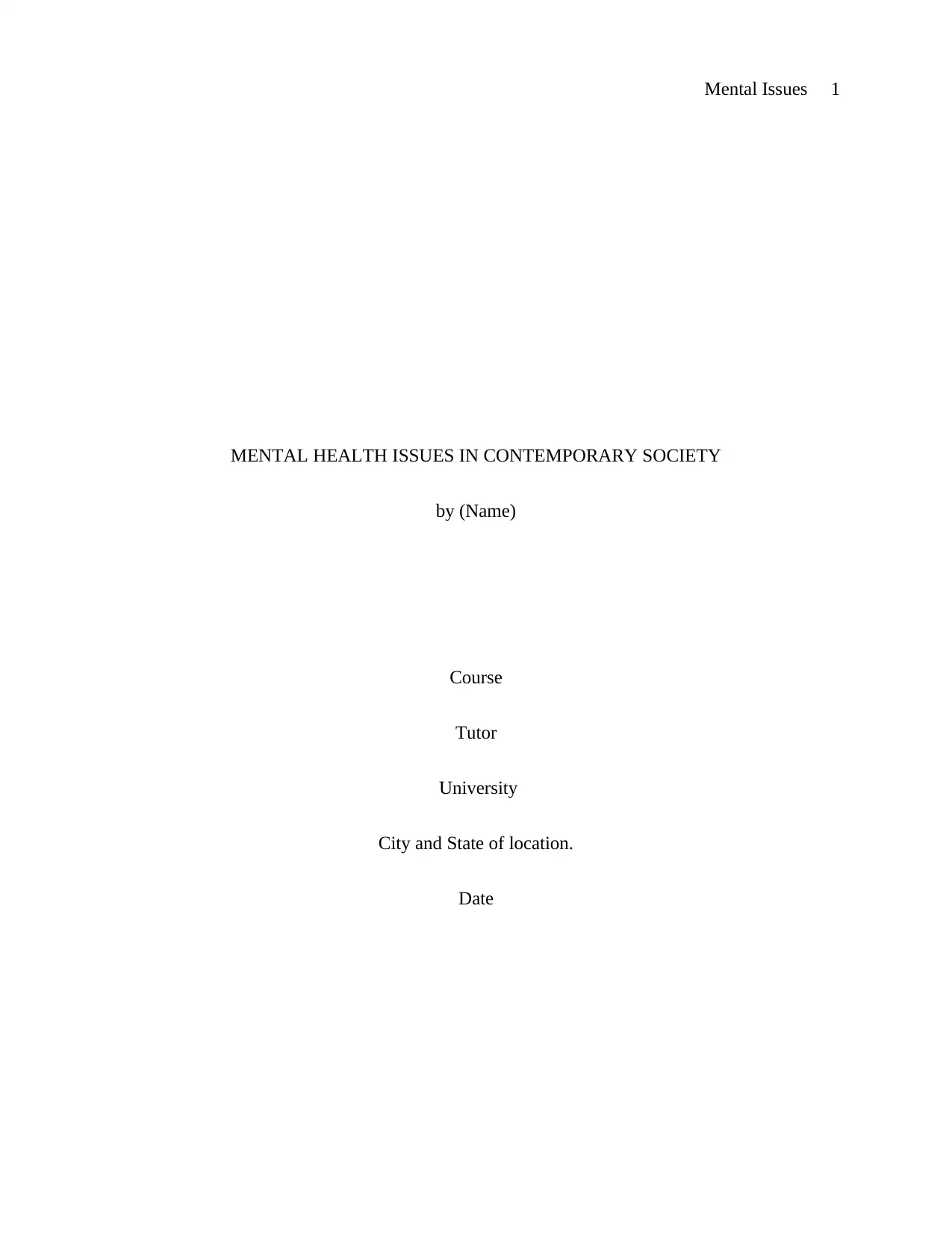
Mental Issues 1
MENTAL HEALTH ISSUES IN CONTEMPORARY SOCIETY
by (Name)
Course
Tutor
University
City and State of location.
Date
MENTAL HEALTH ISSUES IN CONTEMPORARY SOCIETY
by (Name)
Course
Tutor
University
City and State of location.
Date
Secure Best Marks with AI Grader
Need help grading? Try our AI Grader for instant feedback on your assignments.
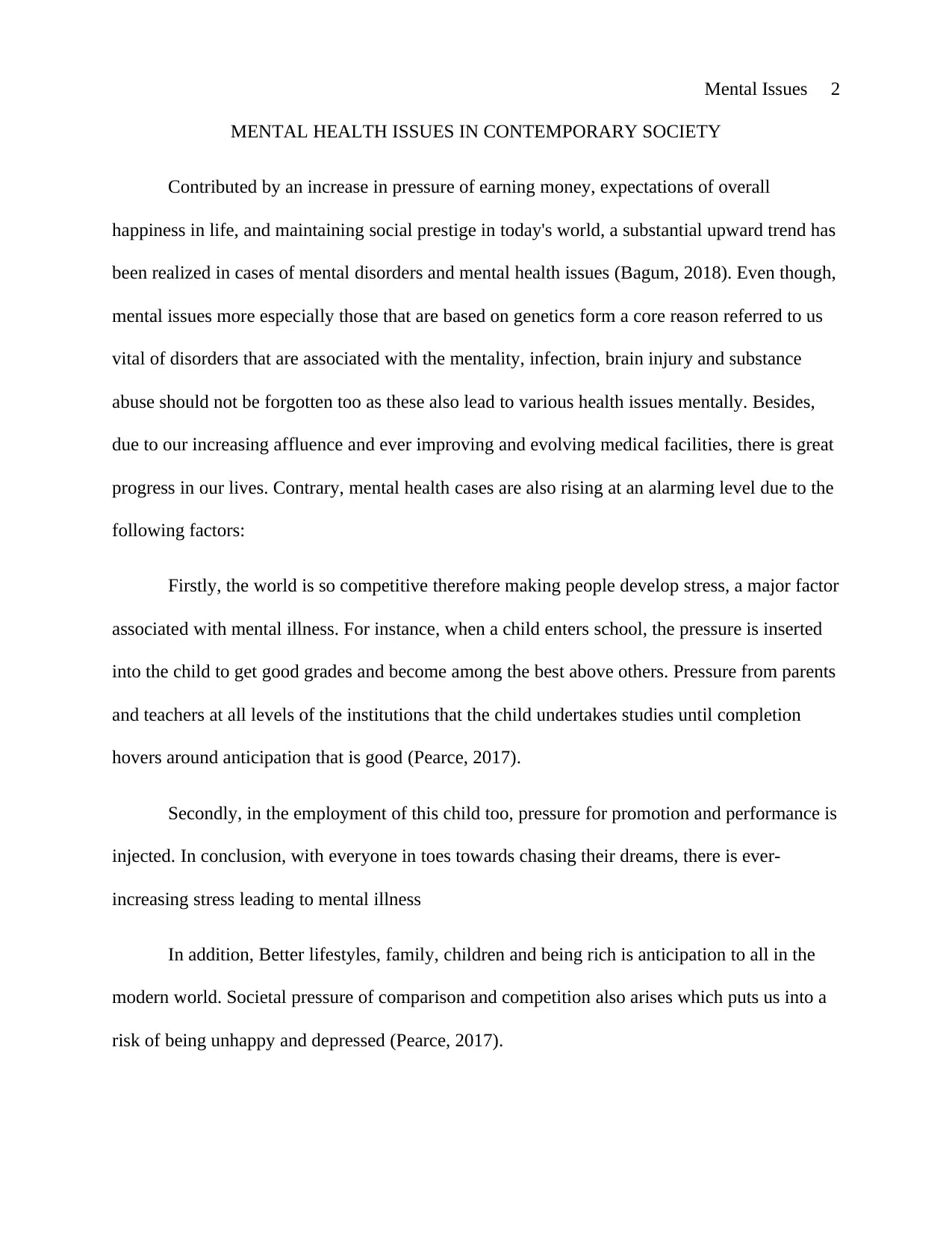
Mental Issues 2
MENTAL HEALTH ISSUES IN CONTEMPORARY SOCIETY
Contributed by an increase in pressure of earning money, expectations of overall
happiness in life, and maintaining social prestige in today's world, a substantial upward trend has
been realized in cases of mental disorders and mental health issues (Bagum, 2018). Even though,
mental issues more especially those that are based on genetics form a core reason referred to us
vital of disorders that are associated with the mentality, infection, brain injury and substance
abuse should not be forgotten too as these also lead to various health issues mentally. Besides,
due to our increasing affluence and ever improving and evolving medical facilities, there is great
progress in our lives. Contrary, mental health cases are also rising at an alarming level due to the
following factors:
Firstly, the world is so competitive therefore making people develop stress, a major factor
associated with mental illness. For instance, when a child enters school, the pressure is inserted
into the child to get good grades and become among the best above others. Pressure from parents
and teachers at all levels of the institutions that the child undertakes studies until completion
hovers around anticipation that is good (Pearce, 2017).
Secondly, in the employment of this child too, pressure for promotion and performance is
injected. In conclusion, with everyone in toes towards chasing their dreams, there is ever-
increasing stress leading to mental illness
In addition, Better lifestyles, family, children and being rich is anticipation to all in the
modern world. Societal pressure of comparison and competition also arises which puts us into a
risk of being unhappy and depressed (Pearce, 2017).
MENTAL HEALTH ISSUES IN CONTEMPORARY SOCIETY
Contributed by an increase in pressure of earning money, expectations of overall
happiness in life, and maintaining social prestige in today's world, a substantial upward trend has
been realized in cases of mental disorders and mental health issues (Bagum, 2018). Even though,
mental issues more especially those that are based on genetics form a core reason referred to us
vital of disorders that are associated with the mentality, infection, brain injury and substance
abuse should not be forgotten too as these also lead to various health issues mentally. Besides,
due to our increasing affluence and ever improving and evolving medical facilities, there is great
progress in our lives. Contrary, mental health cases are also rising at an alarming level due to the
following factors:
Firstly, the world is so competitive therefore making people develop stress, a major factor
associated with mental illness. For instance, when a child enters school, the pressure is inserted
into the child to get good grades and become among the best above others. Pressure from parents
and teachers at all levels of the institutions that the child undertakes studies until completion
hovers around anticipation that is good (Pearce, 2017).
Secondly, in the employment of this child too, pressure for promotion and performance is
injected. In conclusion, with everyone in toes towards chasing their dreams, there is ever-
increasing stress leading to mental illness
In addition, Better lifestyles, family, children and being rich is anticipation to all in the
modern world. Societal pressure of comparison and competition also arises which puts us into a
risk of being unhappy and depressed (Pearce, 2017).
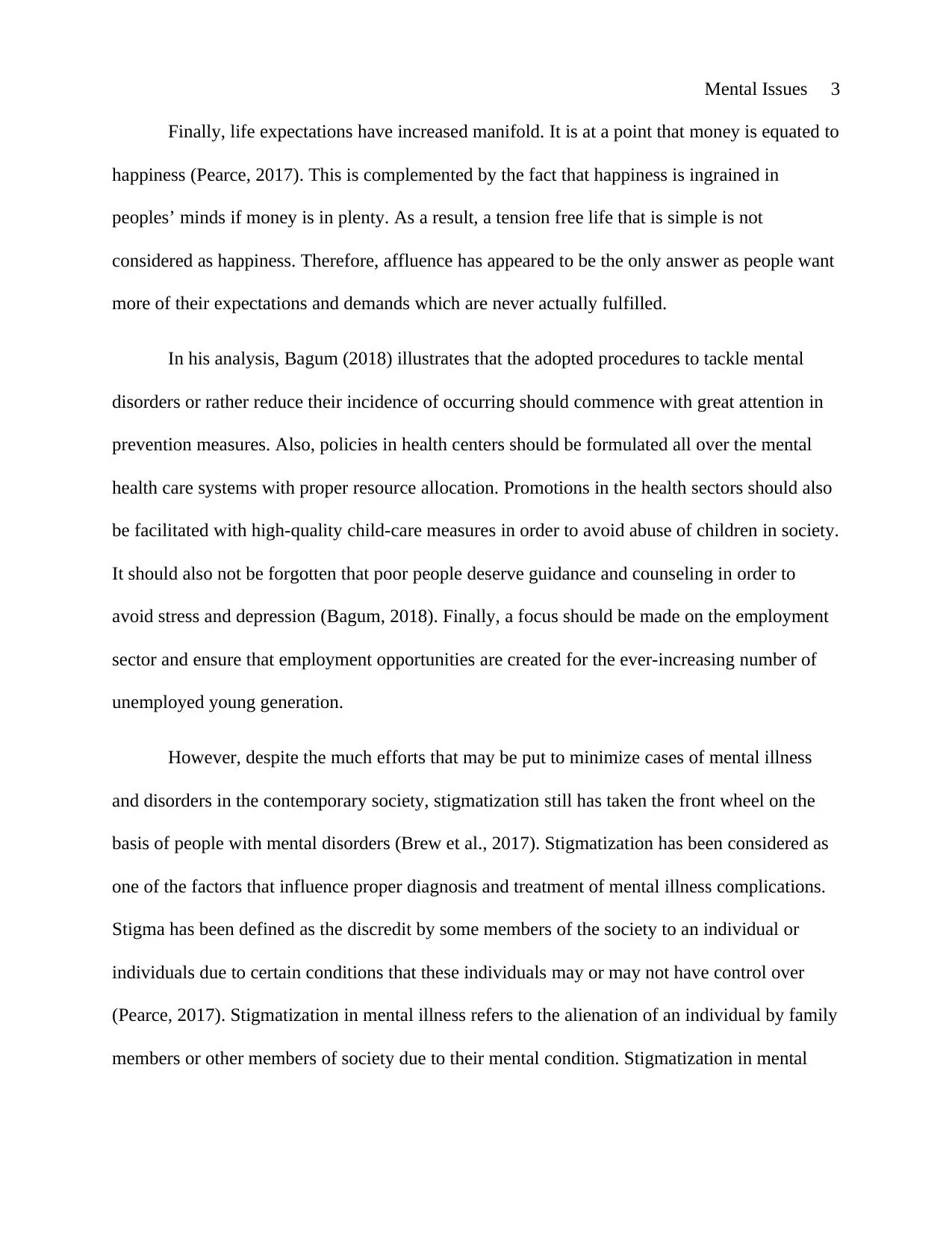
Mental Issues 3
Finally, life expectations have increased manifold. It is at a point that money is equated to
happiness (Pearce, 2017). This is complemented by the fact that happiness is ingrained in
peoples’ minds if money is in plenty. As a result, a tension free life that is simple is not
considered as happiness. Therefore, affluence has appeared to be the only answer as people want
more of their expectations and demands which are never actually fulfilled.
In his analysis, Bagum (2018) illustrates that the adopted procedures to tackle mental
disorders or rather reduce their incidence of occurring should commence with great attention in
prevention measures. Also, policies in health centers should be formulated all over the mental
health care systems with proper resource allocation. Promotions in the health sectors should also
be facilitated with high-quality child-care measures in order to avoid abuse of children in society.
It should also not be forgotten that poor people deserve guidance and counseling in order to
avoid stress and depression (Bagum, 2018). Finally, a focus should be made on the employment
sector and ensure that employment opportunities are created for the ever-increasing number of
unemployed young generation.
However, despite the much efforts that may be put to minimize cases of mental illness
and disorders in the contemporary society, stigmatization still has taken the front wheel on the
basis of people with mental disorders (Brew et al., 2017). Stigmatization has been considered as
one of the factors that influence proper diagnosis and treatment of mental illness complications.
Stigma has been defined as the discredit by some members of the society to an individual or
individuals due to certain conditions that these individuals may or may not have control over
(Pearce, 2017). Stigmatization in mental illness refers to the alienation of an individual by family
members or other members of society due to their mental condition. Stigmatization in mental
Finally, life expectations have increased manifold. It is at a point that money is equated to
happiness (Pearce, 2017). This is complemented by the fact that happiness is ingrained in
peoples’ minds if money is in plenty. As a result, a tension free life that is simple is not
considered as happiness. Therefore, affluence has appeared to be the only answer as people want
more of their expectations and demands which are never actually fulfilled.
In his analysis, Bagum (2018) illustrates that the adopted procedures to tackle mental
disorders or rather reduce their incidence of occurring should commence with great attention in
prevention measures. Also, policies in health centers should be formulated all over the mental
health care systems with proper resource allocation. Promotions in the health sectors should also
be facilitated with high-quality child-care measures in order to avoid abuse of children in society.
It should also not be forgotten that poor people deserve guidance and counseling in order to
avoid stress and depression (Bagum, 2018). Finally, a focus should be made on the employment
sector and ensure that employment opportunities are created for the ever-increasing number of
unemployed young generation.
However, despite the much efforts that may be put to minimize cases of mental illness
and disorders in the contemporary society, stigmatization still has taken the front wheel on the
basis of people with mental disorders (Brew et al., 2017). Stigmatization has been considered as
one of the factors that influence proper diagnosis and treatment of mental illness complications.
Stigma has been defined as the discredit by some members of the society to an individual or
individuals due to certain conditions that these individuals may or may not have control over
(Pearce, 2017). Stigmatization in mental illness refers to the alienation of an individual by family
members or other members of society due to their mental condition. Stigmatization in mental
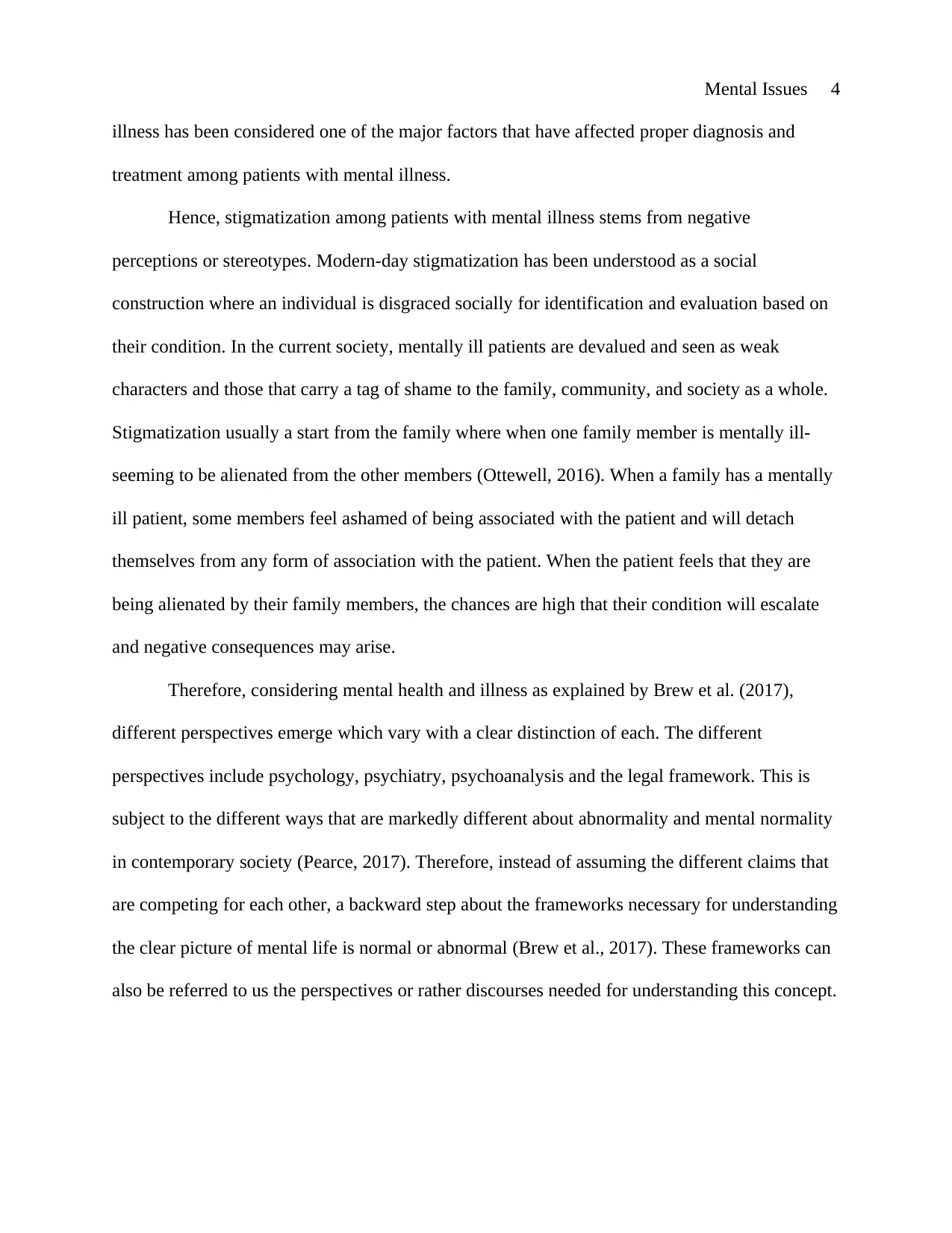
Mental Issues 4
illness has been considered one of the major factors that have affected proper diagnosis and
treatment among patients with mental illness.
Hence, stigmatization among patients with mental illness stems from negative
perceptions or stereotypes. Modern-day stigmatization has been understood as a social
construction where an individual is disgraced socially for identification and evaluation based on
their condition. In the current society, mentally ill patients are devalued and seen as weak
characters and those that carry a tag of shame to the family, community, and society as a whole.
Stigmatization usually a start from the family where when one family member is mentally ill-
seeming to be alienated from the other members (Ottewell, 2016). When a family has a mentally
ill patient, some members feel ashamed of being associated with the patient and will detach
themselves from any form of association with the patient. When the patient feels that they are
being alienated by their family members, the chances are high that their condition will escalate
and negative consequences may arise.
Therefore, considering mental health and illness as explained by Brew et al. (2017),
different perspectives emerge which vary with a clear distinction of each. The different
perspectives include psychology, psychiatry, psychoanalysis and the legal framework. This is
subject to the different ways that are markedly different about abnormality and mental normality
in contemporary society (Pearce, 2017). Therefore, instead of assuming the different claims that
are competing for each other, a backward step about the frameworks necessary for understanding
the clear picture of mental life is normal or abnormal (Brew et al., 2017). These frameworks can
also be referred to us the perspectives or rather discourses needed for understanding this concept.
illness has been considered one of the major factors that have affected proper diagnosis and
treatment among patients with mental illness.
Hence, stigmatization among patients with mental illness stems from negative
perceptions or stereotypes. Modern-day stigmatization has been understood as a social
construction where an individual is disgraced socially for identification and evaluation based on
their condition. In the current society, mentally ill patients are devalued and seen as weak
characters and those that carry a tag of shame to the family, community, and society as a whole.
Stigmatization usually a start from the family where when one family member is mentally ill-
seeming to be alienated from the other members (Ottewell, 2016). When a family has a mentally
ill patient, some members feel ashamed of being associated with the patient and will detach
themselves from any form of association with the patient. When the patient feels that they are
being alienated by their family members, the chances are high that their condition will escalate
and negative consequences may arise.
Therefore, considering mental health and illness as explained by Brew et al. (2017),
different perspectives emerge which vary with a clear distinction of each. The different
perspectives include psychology, psychiatry, psychoanalysis and the legal framework. This is
subject to the different ways that are markedly different about abnormality and mental normality
in contemporary society (Pearce, 2017). Therefore, instead of assuming the different claims that
are competing for each other, a backward step about the frameworks necessary for understanding
the clear picture of mental life is normal or abnormal (Brew et al., 2017). These frameworks can
also be referred to us the perspectives or rather discourses needed for understanding this concept.
Secure Best Marks with AI Grader
Need help grading? Try our AI Grader for instant feedback on your assignments.
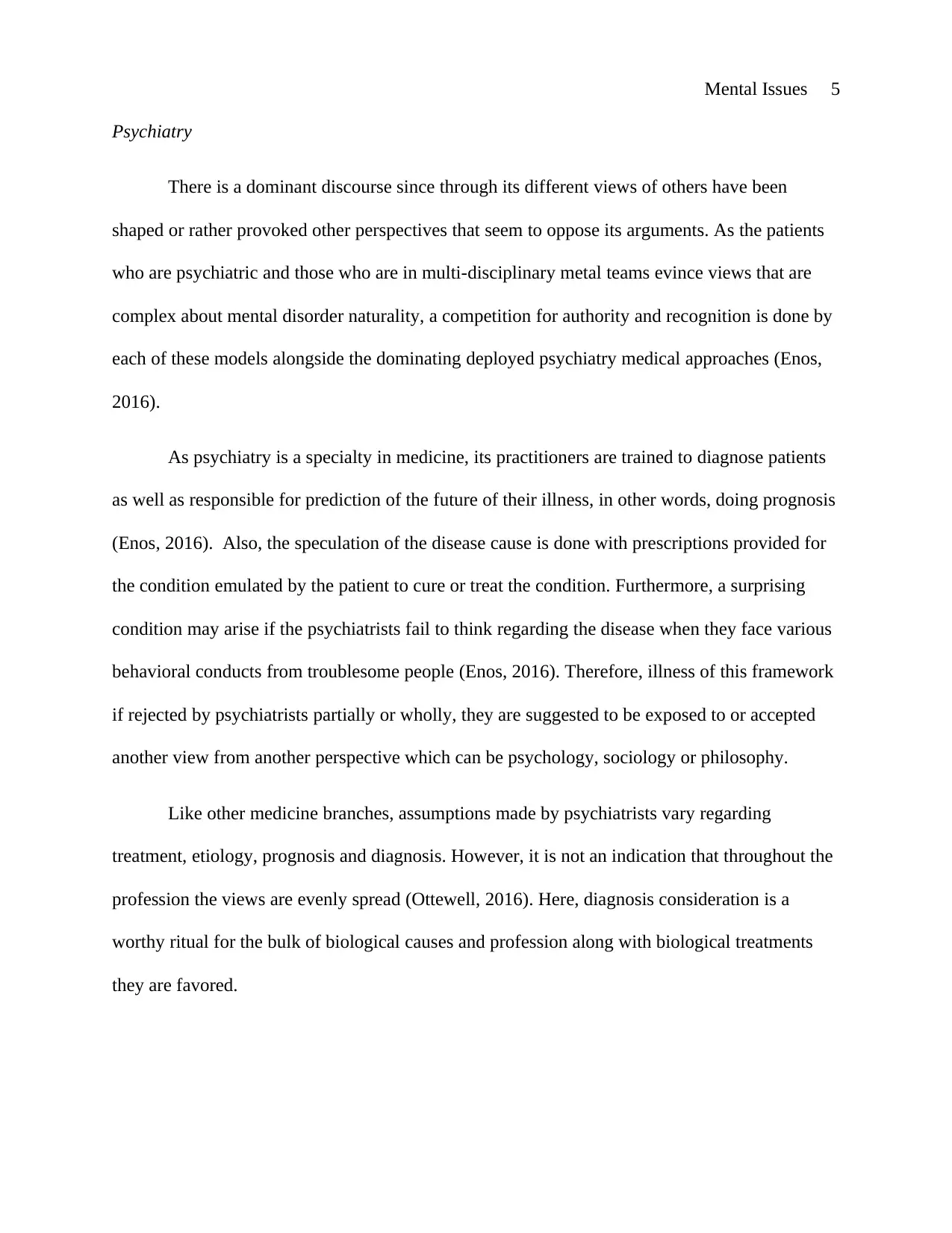
Mental Issues 5
Psychiatry
There is a dominant discourse since through its different views of others have been
shaped or rather provoked other perspectives that seem to oppose its arguments. As the patients
who are psychiatric and those who are in multi-disciplinary metal teams evince views that are
complex about mental disorder naturality, a competition for authority and recognition is done by
each of these models alongside the dominating deployed psychiatry medical approaches (Enos,
2016).
As psychiatry is a specialty in medicine, its practitioners are trained to diagnose patients
as well as responsible for prediction of the future of their illness, in other words, doing prognosis
(Enos, 2016). Also, the speculation of the disease cause is done with prescriptions provided for
the condition emulated by the patient to cure or treat the condition. Furthermore, a surprising
condition may arise if the psychiatrists fail to think regarding the disease when they face various
behavioral conducts from troublesome people (Enos, 2016). Therefore, illness of this framework
if rejected by psychiatrists partially or wholly, they are suggested to be exposed to or accepted
another view from another perspective which can be psychology, sociology or philosophy.
Like other medicine branches, assumptions made by psychiatrists vary regarding
treatment, etiology, prognosis and diagnosis. However, it is not an indication that throughout the
profession the views are evenly spread (Ottewell, 2016). Here, diagnosis consideration is a
worthy ritual for the bulk of biological causes and profession along with biological treatments
they are favored.
Psychiatry
There is a dominant discourse since through its different views of others have been
shaped or rather provoked other perspectives that seem to oppose its arguments. As the patients
who are psychiatric and those who are in multi-disciplinary metal teams evince views that are
complex about mental disorder naturality, a competition for authority and recognition is done by
each of these models alongside the dominating deployed psychiatry medical approaches (Enos,
2016).
As psychiatry is a specialty in medicine, its practitioners are trained to diagnose patients
as well as responsible for prediction of the future of their illness, in other words, doing prognosis
(Enos, 2016). Also, the speculation of the disease cause is done with prescriptions provided for
the condition emulated by the patient to cure or treat the condition. Furthermore, a surprising
condition may arise if the psychiatrists fail to think regarding the disease when they face various
behavioral conducts from troublesome people (Enos, 2016). Therefore, illness of this framework
if rejected by psychiatrists partially or wholly, they are suggested to be exposed to or accepted
another view from another perspective which can be psychology, sociology or philosophy.
Like other medicine branches, assumptions made by psychiatrists vary regarding
treatment, etiology, prognosis and diagnosis. However, it is not an indication that throughout the
profession the views are evenly spread (Ottewell, 2016). Here, diagnosis consideration is a
worthy ritual for the bulk of biological causes and profession along with biological treatments
they are favored.
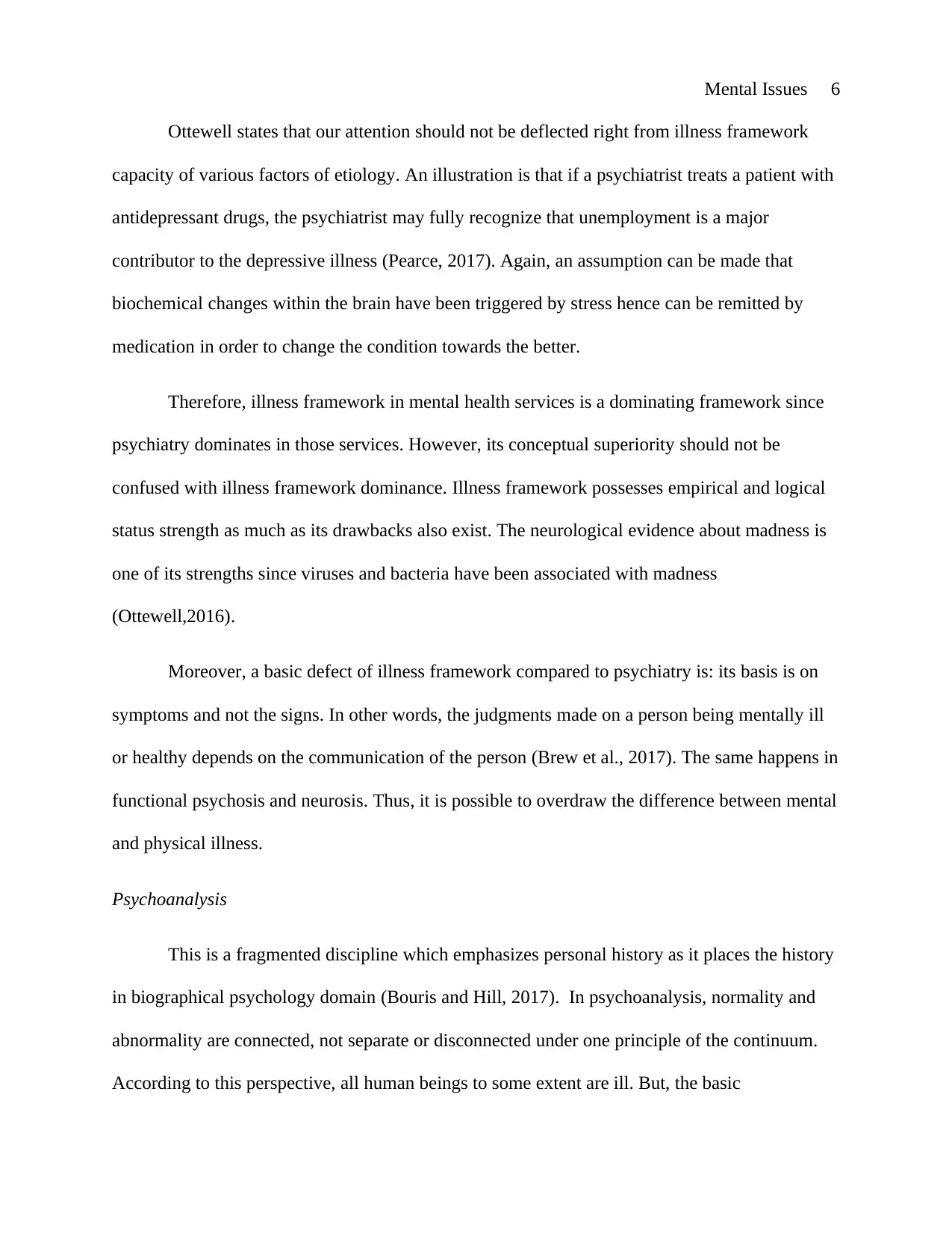
Mental Issues 6
Ottewell states that our attention should not be deflected right from illness framework
capacity of various factors of etiology. An illustration is that if a psychiatrist treats a patient with
antidepressant drugs, the psychiatrist may fully recognize that unemployment is a major
contributor to the depressive illness (Pearce, 2017). Again, an assumption can be made that
biochemical changes within the brain have been triggered by stress hence can be remitted by
medication in order to change the condition towards the better.
Therefore, illness framework in mental health services is a dominating framework since
psychiatry dominates in those services. However, its conceptual superiority should not be
confused with illness framework dominance. Illness framework possesses empirical and logical
status strength as much as its drawbacks also exist. The neurological evidence about madness is
one of its strengths since viruses and bacteria have been associated with madness
(Ottewell,2016).
Moreover, a basic defect of illness framework compared to psychiatry is: its basis is on
symptoms and not the signs. In other words, the judgments made on a person being mentally ill
or healthy depends on the communication of the person (Brew et al., 2017). The same happens in
functional psychosis and neurosis. Thus, it is possible to overdraw the difference between mental
and physical illness.
Psychoanalysis
This is a fragmented discipline which emphasizes personal history as it places the history
in biographical psychology domain (Bouris and Hill, 2017). In psychoanalysis, normality and
abnormality are connected, not separate or disconnected under one principle of the continuum.
According to this perspective, all human beings to some extent are ill. But, the basic
Ottewell states that our attention should not be deflected right from illness framework
capacity of various factors of etiology. An illustration is that if a psychiatrist treats a patient with
antidepressant drugs, the psychiatrist may fully recognize that unemployment is a major
contributor to the depressive illness (Pearce, 2017). Again, an assumption can be made that
biochemical changes within the brain have been triggered by stress hence can be remitted by
medication in order to change the condition towards the better.
Therefore, illness framework in mental health services is a dominating framework since
psychiatry dominates in those services. However, its conceptual superiority should not be
confused with illness framework dominance. Illness framework possesses empirical and logical
status strength as much as its drawbacks also exist. The neurological evidence about madness is
one of its strengths since viruses and bacteria have been associated with madness
(Ottewell,2016).
Moreover, a basic defect of illness framework compared to psychiatry is: its basis is on
symptoms and not the signs. In other words, the judgments made on a person being mentally ill
or healthy depends on the communication of the person (Brew et al., 2017). The same happens in
functional psychosis and neurosis. Thus, it is possible to overdraw the difference between mental
and physical illness.
Psychoanalysis
This is a fragmented discipline which emphasizes personal history as it places the history
in biographical psychology domain (Bouris and Hill, 2017). In psychoanalysis, normality and
abnormality are connected, not separate or disconnected under one principle of the continuum.
According to this perspective, all human beings to some extent are ill. But, the basic
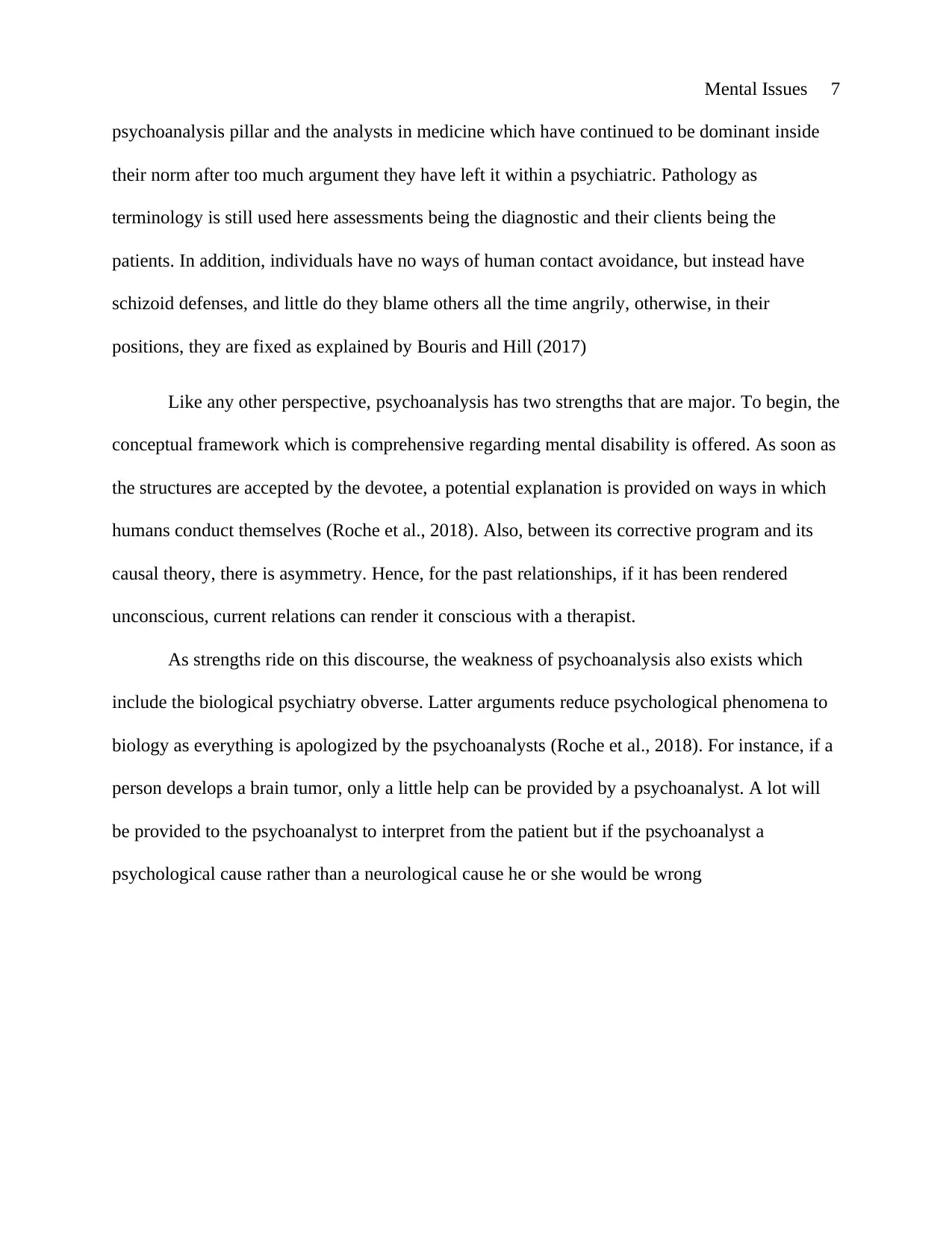
Mental Issues 7
psychoanalysis pillar and the analysts in medicine which have continued to be dominant inside
their norm after too much argument they have left it within a psychiatric. Pathology as
terminology is still used here assessments being the diagnostic and their clients being the
patients. In addition, individuals have no ways of human contact avoidance, but instead have
schizoid defenses, and little do they blame others all the time angrily, otherwise, in their
positions, they are fixed as explained by Bouris and Hill (2017)
Like any other perspective, psychoanalysis has two strengths that are major. To begin, the
conceptual framework which is comprehensive regarding mental disability is offered. As soon as
the structures are accepted by the devotee, a potential explanation is provided on ways in which
humans conduct themselves (Roche et al., 2018). Also, between its corrective program and its
causal theory, there is asymmetry. Hence, for the past relationships, if it has been rendered
unconscious, current relations can render it conscious with a therapist.
As strengths ride on this discourse, the weakness of psychoanalysis also exists which
include the biological psychiatry obverse. Latter arguments reduce psychological phenomena to
biology as everything is apologized by the psychoanalysts (Roche et al., 2018). For instance, if a
person develops a brain tumor, only a little help can be provided by a psychoanalyst. A lot will
be provided to the psychoanalyst to interpret from the patient but if the psychoanalyst a
psychological cause rather than a neurological cause he or she would be wrong
psychoanalysis pillar and the analysts in medicine which have continued to be dominant inside
their norm after too much argument they have left it within a psychiatric. Pathology as
terminology is still used here assessments being the diagnostic and their clients being the
patients. In addition, individuals have no ways of human contact avoidance, but instead have
schizoid defenses, and little do they blame others all the time angrily, otherwise, in their
positions, they are fixed as explained by Bouris and Hill (2017)
Like any other perspective, psychoanalysis has two strengths that are major. To begin, the
conceptual framework which is comprehensive regarding mental disability is offered. As soon as
the structures are accepted by the devotee, a potential explanation is provided on ways in which
humans conduct themselves (Roche et al., 2018). Also, between its corrective program and its
causal theory, there is asymmetry. Hence, for the past relationships, if it has been rendered
unconscious, current relations can render it conscious with a therapist.
As strengths ride on this discourse, the weakness of psychoanalysis also exists which
include the biological psychiatry obverse. Latter arguments reduce psychological phenomena to
biology as everything is apologized by the psychoanalysts (Roche et al., 2018). For instance, if a
person develops a brain tumor, only a little help can be provided by a psychoanalyst. A lot will
be provided to the psychoanalyst to interpret from the patient but if the psychoanalyst a
psychological cause rather than a neurological cause he or she would be wrong
Paraphrase This Document
Need a fresh take? Get an instant paraphrase of this document with our AI Paraphraser
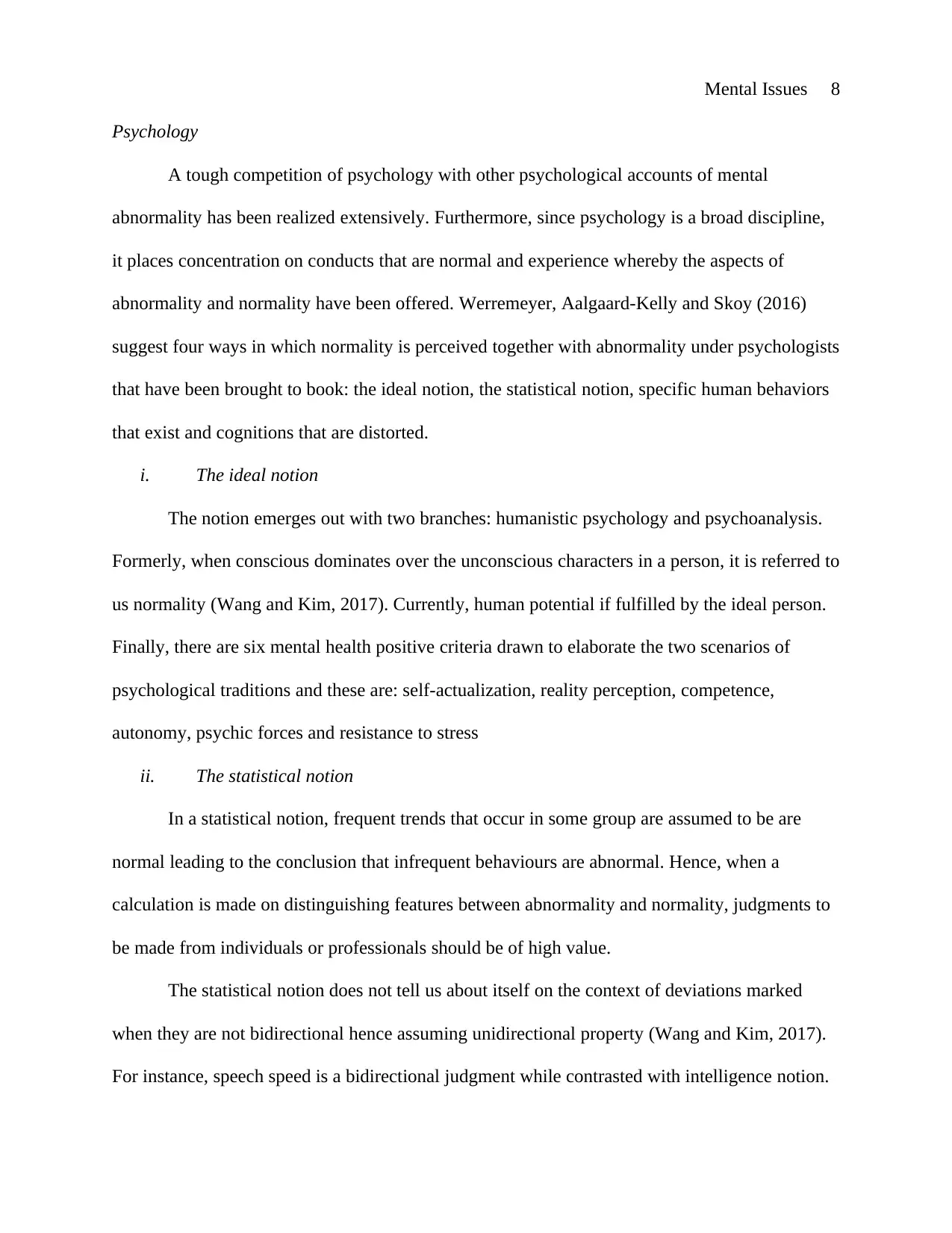
Mental Issues 8
Psychology
A tough competition of psychology with other psychological accounts of mental
abnormality has been realized extensively. Furthermore, since psychology is a broad discipline,
it places concentration on conducts that are normal and experience whereby the aspects of
abnormality and normality have been offered. Werremeyer, Aalgaard-Kelly and Skoy (2016)
suggest four ways in which normality is perceived together with abnormality under psychologists
that have been brought to book: the ideal notion, the statistical notion, specific human behaviors
that exist and cognitions that are distorted.
i. The ideal notion
The notion emerges out with two branches: humanistic psychology and psychoanalysis.
Formerly, when conscious dominates over the unconscious characters in a person, it is referred to
us normality (Wang and Kim, 2017). Currently, human potential if fulfilled by the ideal person.
Finally, there are six mental health positive criteria drawn to elaborate the two scenarios of
psychological traditions and these are: self-actualization, reality perception, competence,
autonomy, psychic forces and resistance to stress
ii. The statistical notion
In a statistical notion, frequent trends that occur in some group are assumed to be are
normal leading to the conclusion that infrequent behaviours are abnormal. Hence, when a
calculation is made on distinguishing features between abnormality and normality, judgments to
be made from individuals or professionals should be of high value.
The statistical notion does not tell us about itself on the context of deviations marked
when they are not bidirectional hence assuming unidirectional property (Wang and Kim, 2017).
For instance, speech speed is a bidirectional judgment while contrasted with intelligence notion.
Psychology
A tough competition of psychology with other psychological accounts of mental
abnormality has been realized extensively. Furthermore, since psychology is a broad discipline,
it places concentration on conducts that are normal and experience whereby the aspects of
abnormality and normality have been offered. Werremeyer, Aalgaard-Kelly and Skoy (2016)
suggest four ways in which normality is perceived together with abnormality under psychologists
that have been brought to book: the ideal notion, the statistical notion, specific human behaviors
that exist and cognitions that are distorted.
i. The ideal notion
The notion emerges out with two branches: humanistic psychology and psychoanalysis.
Formerly, when conscious dominates over the unconscious characters in a person, it is referred to
us normality (Wang and Kim, 2017). Currently, human potential if fulfilled by the ideal person.
Finally, there are six mental health positive criteria drawn to elaborate the two scenarios of
psychological traditions and these are: self-actualization, reality perception, competence,
autonomy, psychic forces and resistance to stress
ii. The statistical notion
In a statistical notion, frequent trends that occur in some group are assumed to be are
normal leading to the conclusion that infrequent behaviours are abnormal. Hence, when a
calculation is made on distinguishing features between abnormality and normality, judgments to
be made from individuals or professionals should be of high value.
The statistical notion does not tell us about itself on the context of deviations marked
when they are not bidirectional hence assuming unidirectional property (Wang and Kim, 2017).
For instance, speech speed is a bidirectional judgment while contrasted with intelligence notion.
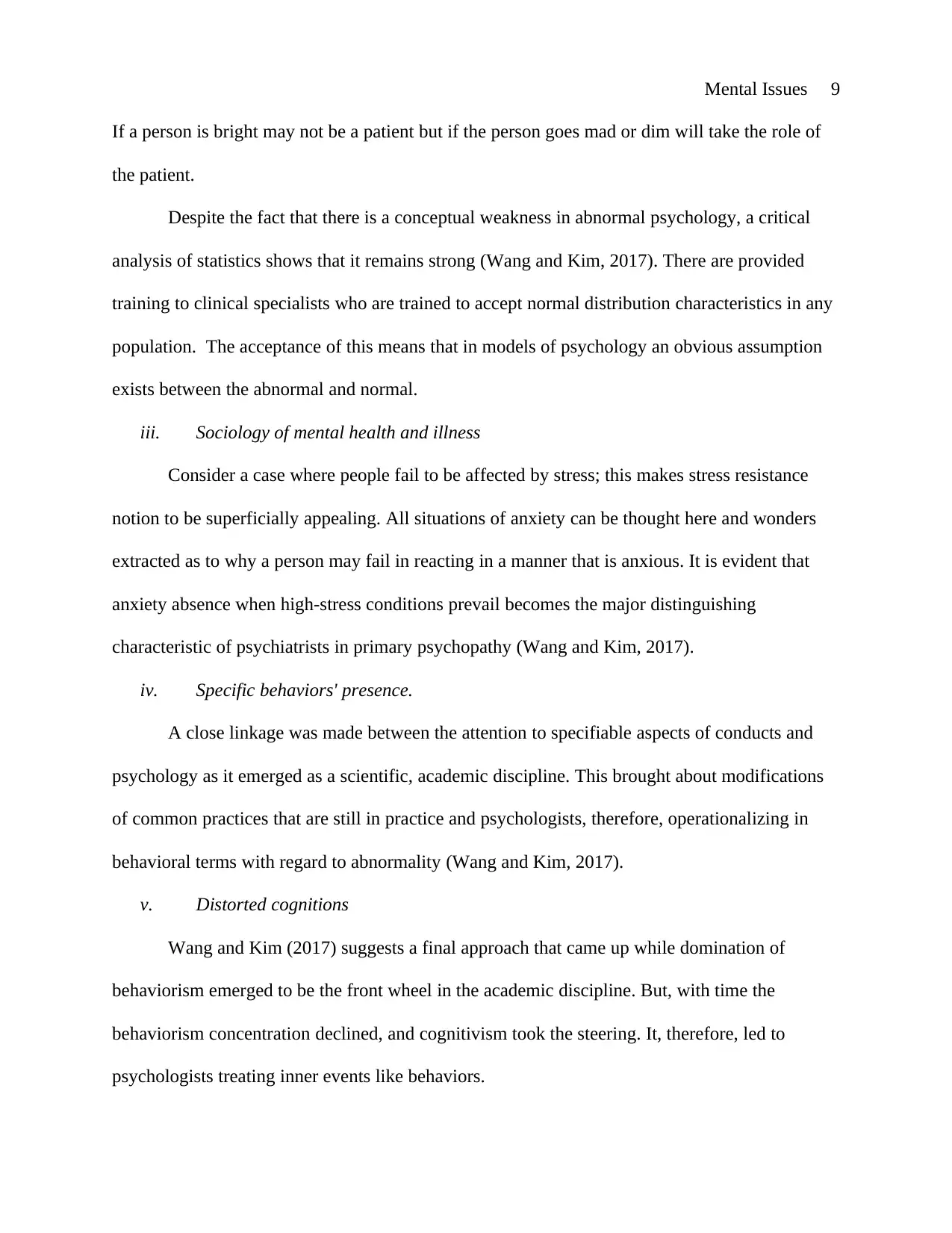
Mental Issues 9
If a person is bright may not be a patient but if the person goes mad or dim will take the role of
the patient.
Despite the fact that there is a conceptual weakness in abnormal psychology, a critical
analysis of statistics shows that it remains strong (Wang and Kim, 2017). There are provided
training to clinical specialists who are trained to accept normal distribution characteristics in any
population. The acceptance of this means that in models of psychology an obvious assumption
exists between the abnormal and normal.
iii. Sociology of mental health and illness
Consider a case where people fail to be affected by stress; this makes stress resistance
notion to be superficially appealing. All situations of anxiety can be thought here and wonders
extracted as to why a person may fail in reacting in a manner that is anxious. It is evident that
anxiety absence when high-stress conditions prevail becomes the major distinguishing
characteristic of psychiatrists in primary psychopathy (Wang and Kim, 2017).
iv. Specific behaviors' presence.
A close linkage was made between the attention to specifiable aspects of conducts and
psychology as it emerged as a scientific, academic discipline. This brought about modifications
of common practices that are still in practice and psychologists, therefore, operationalizing in
behavioral terms with regard to abnormality (Wang and Kim, 2017).
v. Distorted cognitions
Wang and Kim (2017) suggests a final approach that came up while domination of
behaviorism emerged to be the front wheel in the academic discipline. But, with time the
behaviorism concentration declined, and cognitivism took the steering. It, therefore, led to
psychologists treating inner events like behaviors.
If a person is bright may not be a patient but if the person goes mad or dim will take the role of
the patient.
Despite the fact that there is a conceptual weakness in abnormal psychology, a critical
analysis of statistics shows that it remains strong (Wang and Kim, 2017). There are provided
training to clinical specialists who are trained to accept normal distribution characteristics in any
population. The acceptance of this means that in models of psychology an obvious assumption
exists between the abnormal and normal.
iii. Sociology of mental health and illness
Consider a case where people fail to be affected by stress; this makes stress resistance
notion to be superficially appealing. All situations of anxiety can be thought here and wonders
extracted as to why a person may fail in reacting in a manner that is anxious. It is evident that
anxiety absence when high-stress conditions prevail becomes the major distinguishing
characteristic of psychiatrists in primary psychopathy (Wang and Kim, 2017).
iv. Specific behaviors' presence.
A close linkage was made between the attention to specifiable aspects of conducts and
psychology as it emerged as a scientific, academic discipline. This brought about modifications
of common practices that are still in practice and psychologists, therefore, operationalizing in
behavioral terms with regard to abnormality (Wang and Kim, 2017).
v. Distorted cognitions
Wang and Kim (2017) suggests a final approach that came up while domination of
behaviorism emerged to be the front wheel in the academic discipline. But, with time the
behaviorism concentration declined, and cognitivism took the steering. It, therefore, led to
psychologists treating inner events like behaviors.
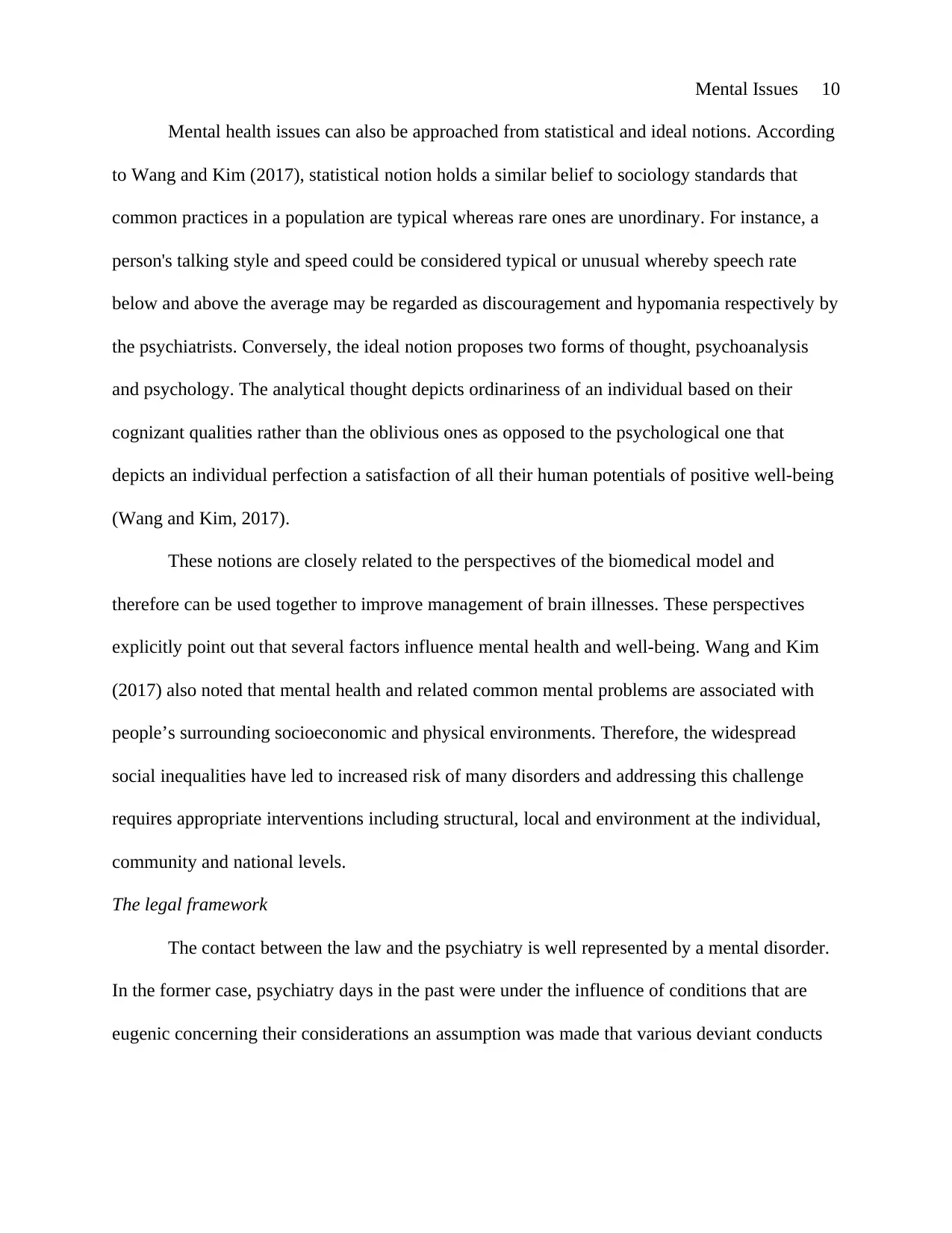
Mental Issues 10
Mental health issues can also be approached from statistical and ideal notions. According
to Wang and Kim (2017), statistical notion holds a similar belief to sociology standards that
common practices in a population are typical whereas rare ones are unordinary. For instance, a
person's talking style and speed could be considered typical or unusual whereby speech rate
below and above the average may be regarded as discouragement and hypomania respectively by
the psychiatrists. Conversely, the ideal notion proposes two forms of thought, psychoanalysis
and psychology. The analytical thought depicts ordinariness of an individual based on their
cognizant qualities rather than the oblivious ones as opposed to the psychological one that
depicts an individual perfection a satisfaction of all their human potentials of positive well-being
(Wang and Kim, 2017).
These notions are closely related to the perspectives of the biomedical model and
therefore can be used together to improve management of brain illnesses. These perspectives
explicitly point out that several factors influence mental health and well-being. Wang and Kim
(2017) also noted that mental health and related common mental problems are associated with
people’s surrounding socioeconomic and physical environments. Therefore, the widespread
social inequalities have led to increased risk of many disorders and addressing this challenge
requires appropriate interventions including structural, local and environment at the individual,
community and national levels.
The legal framework
The contact between the law and the psychiatry is well represented by a mental disorder.
In the former case, psychiatry days in the past were under the influence of conditions that are
eugenic concerning their considerations an assumption was made that various deviant conducts
Mental health issues can also be approached from statistical and ideal notions. According
to Wang and Kim (2017), statistical notion holds a similar belief to sociology standards that
common practices in a population are typical whereas rare ones are unordinary. For instance, a
person's talking style and speed could be considered typical or unusual whereby speech rate
below and above the average may be regarded as discouragement and hypomania respectively by
the psychiatrists. Conversely, the ideal notion proposes two forms of thought, psychoanalysis
and psychology. The analytical thought depicts ordinariness of an individual based on their
cognizant qualities rather than the oblivious ones as opposed to the psychological one that
depicts an individual perfection a satisfaction of all their human potentials of positive well-being
(Wang and Kim, 2017).
These notions are closely related to the perspectives of the biomedical model and
therefore can be used together to improve management of brain illnesses. These perspectives
explicitly point out that several factors influence mental health and well-being. Wang and Kim
(2017) also noted that mental health and related common mental problems are associated with
people’s surrounding socioeconomic and physical environments. Therefore, the widespread
social inequalities have led to increased risk of many disorders and addressing this challenge
requires appropriate interventions including structural, local and environment at the individual,
community and national levels.
The legal framework
The contact between the law and the psychiatry is well represented by a mental disorder.
In the former case, psychiatry days in the past were under the influence of conditions that are
eugenic concerning their considerations an assumption was made that various deviant conducts
Secure Best Marks with AI Grader
Need help grading? Try our AI Grader for instant feedback on your assignments.
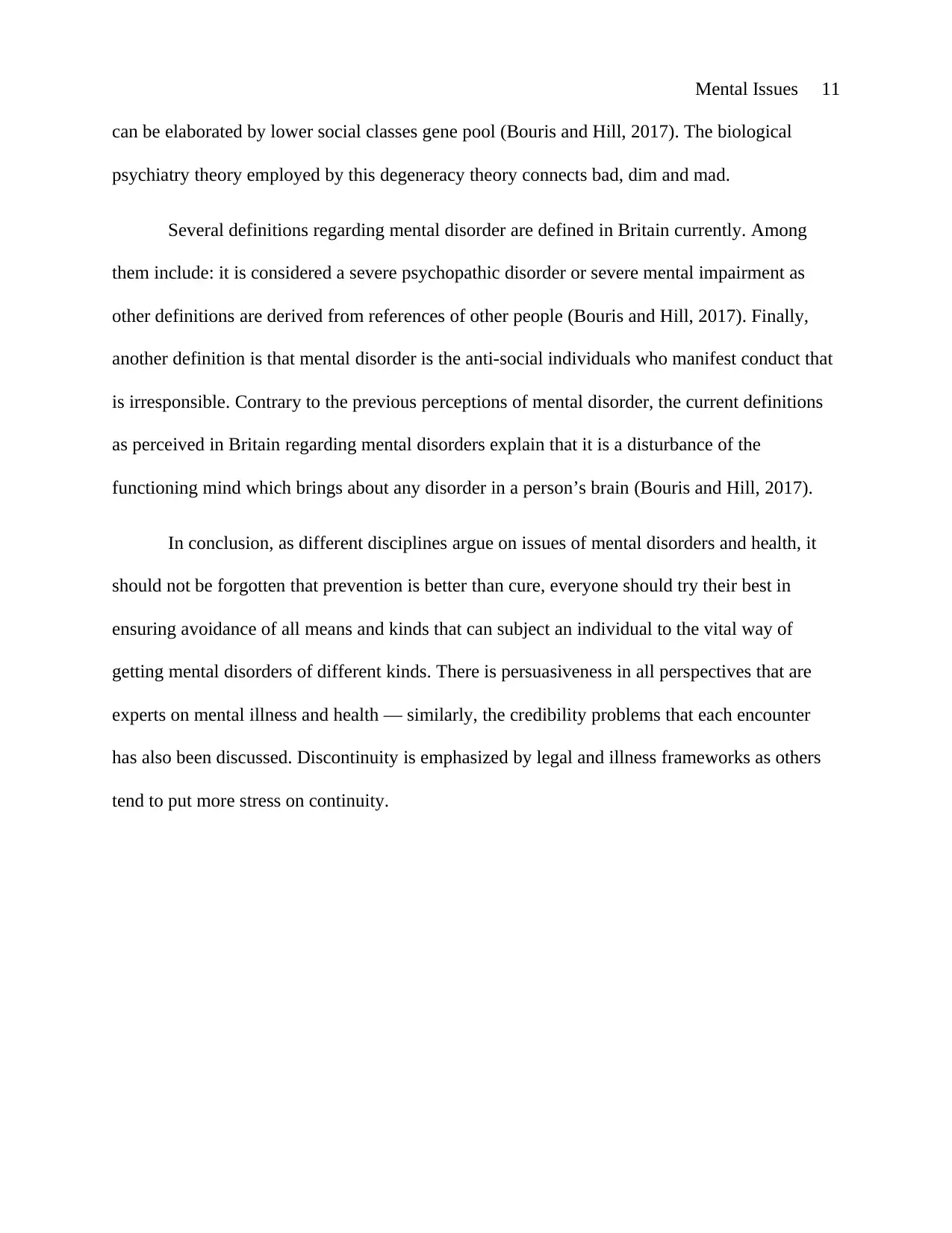
Mental Issues 11
can be elaborated by lower social classes gene pool (Bouris and Hill, 2017). The biological
psychiatry theory employed by this degeneracy theory connects bad, dim and mad.
Several definitions regarding mental disorder are defined in Britain currently. Among
them include: it is considered a severe psychopathic disorder or severe mental impairment as
other definitions are derived from references of other people (Bouris and Hill, 2017). Finally,
another definition is that mental disorder is the anti-social individuals who manifest conduct that
is irresponsible. Contrary to the previous perceptions of mental disorder, the current definitions
as perceived in Britain regarding mental disorders explain that it is a disturbance of the
functioning mind which brings about any disorder in a person’s brain (Bouris and Hill, 2017).
In conclusion, as different disciplines argue on issues of mental disorders and health, it
should not be forgotten that prevention is better than cure, everyone should try their best in
ensuring avoidance of all means and kinds that can subject an individual to the vital way of
getting mental disorders of different kinds. There is persuasiveness in all perspectives that are
experts on mental illness and health — similarly, the credibility problems that each encounter
has also been discussed. Discontinuity is emphasized by legal and illness frameworks as others
tend to put more stress on continuity.
can be elaborated by lower social classes gene pool (Bouris and Hill, 2017). The biological
psychiatry theory employed by this degeneracy theory connects bad, dim and mad.
Several definitions regarding mental disorder are defined in Britain currently. Among
them include: it is considered a severe psychopathic disorder or severe mental impairment as
other definitions are derived from references of other people (Bouris and Hill, 2017). Finally,
another definition is that mental disorder is the anti-social individuals who manifest conduct that
is irresponsible. Contrary to the previous perceptions of mental disorder, the current definitions
as perceived in Britain regarding mental disorders explain that it is a disturbance of the
functioning mind which brings about any disorder in a person’s brain (Bouris and Hill, 2017).
In conclusion, as different disciplines argue on issues of mental disorders and health, it
should not be forgotten that prevention is better than cure, everyone should try their best in
ensuring avoidance of all means and kinds that can subject an individual to the vital way of
getting mental disorders of different kinds. There is persuasiveness in all perspectives that are
experts on mental illness and health — similarly, the credibility problems that each encounter
has also been discussed. Discontinuity is emphasized by legal and illness frameworks as others
tend to put more stress on continuity.
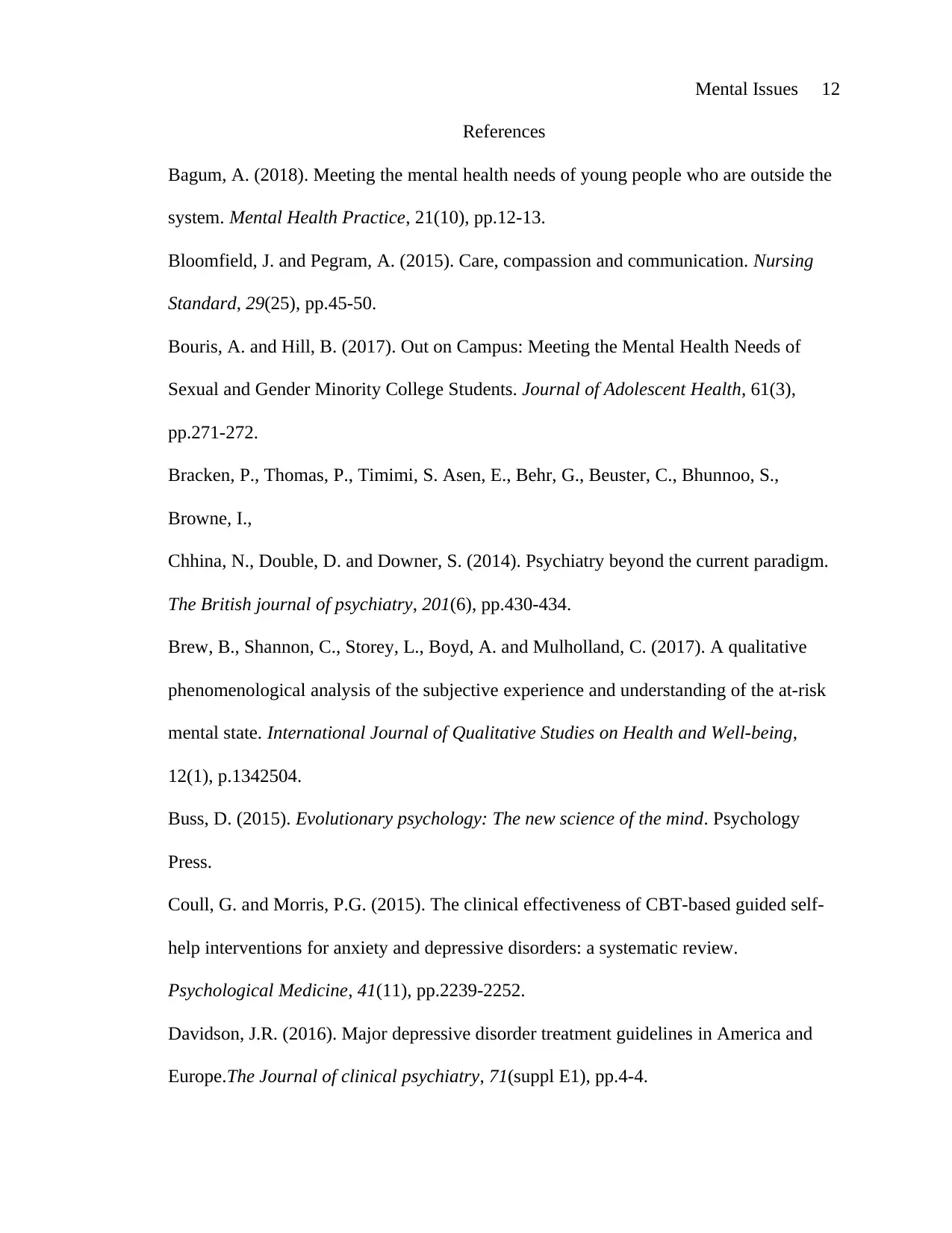
Mental Issues 12
References
Bagum, A. (2018). Meeting the mental health needs of young people who are outside the
system. Mental Health Practice, 21(10), pp.12-13.
Bloomfield, J. and Pegram, A. (2015). Care, compassion and communication. Nursing
Standard, 29(25), pp.45-50.
Bouris, A. and Hill, B. (2017). Out on Campus: Meeting the Mental Health Needs of
Sexual and Gender Minority College Students. Journal of Adolescent Health, 61(3),
pp.271-272.
Bracken, P., Thomas, P., Timimi, S. Asen, E., Behr, G., Beuster, C., Bhunnoo, S.,
Browne, I.,
Chhina, N., Double, D. and Downer, S. (2014). Psychiatry beyond the current paradigm.
The British journal of psychiatry, 201(6), pp.430-434.
Brew, B., Shannon, C., Storey, L., Boyd, A. and Mulholland, C. (2017). A qualitative
phenomenological analysis of the subjective experience and understanding of the at-risk
mental state. International Journal of Qualitative Studies on Health and Well-being,
12(1), p.1342504.
Buss, D. (2015). Evolutionary psychology: The new science of the mind. Psychology
Press.
Coull, G. and Morris, P.G. (2015). The clinical effectiveness of CBT-based guided self-
help interventions for anxiety and depressive disorders: a systematic review.
Psychological Medicine, 41(11), pp.2239-2252.
Davidson, J.R. (2016). Major depressive disorder treatment guidelines in America and
Europe.The Journal of clinical psychiatry, 71(suppl E1), pp.4-4.
References
Bagum, A. (2018). Meeting the mental health needs of young people who are outside the
system. Mental Health Practice, 21(10), pp.12-13.
Bloomfield, J. and Pegram, A. (2015). Care, compassion and communication. Nursing
Standard, 29(25), pp.45-50.
Bouris, A. and Hill, B. (2017). Out on Campus: Meeting the Mental Health Needs of
Sexual and Gender Minority College Students. Journal of Adolescent Health, 61(3),
pp.271-272.
Bracken, P., Thomas, P., Timimi, S. Asen, E., Behr, G., Beuster, C., Bhunnoo, S.,
Browne, I.,
Chhina, N., Double, D. and Downer, S. (2014). Psychiatry beyond the current paradigm.
The British journal of psychiatry, 201(6), pp.430-434.
Brew, B., Shannon, C., Storey, L., Boyd, A. and Mulholland, C. (2017). A qualitative
phenomenological analysis of the subjective experience and understanding of the at-risk
mental state. International Journal of Qualitative Studies on Health and Well-being,
12(1), p.1342504.
Buss, D. (2015). Evolutionary psychology: The new science of the mind. Psychology
Press.
Coull, G. and Morris, P.G. (2015). The clinical effectiveness of CBT-based guided self-
help interventions for anxiety and depressive disorders: a systematic review.
Psychological Medicine, 41(11), pp.2239-2252.
Davidson, J.R. (2016). Major depressive disorder treatment guidelines in America and
Europe.The Journal of clinical psychiatry, 71(suppl E1), pp.4-4.

Mental Issues 13
Deacon, B.J. (2013). The biomedical model of mental disorder: A critical analysis of its
validity, utility, and effects on psychotherapy research. Clinical Psychology Review,
33(7), pp.846-861.
Dirmaier, J., Steinmann, M., Krattenmacher, T., Watzke, B., Barghaan, D., Koch, U. and
Schulz, H. (2017). Non-pharmacological treatment of depressive disorders: a review of
evidence-based treatment options. Reviews on recent clinical trials, 7(2), pp.141-149.
Dorpat, T.L. and Miller, M.L. (2013). Clinical interaction and the analysis of meaning: A
new
psychoanalytic theory. Routledge.
Enos, G. (2016). N.Y. program sets the standard in meeting the behavioural needs of
visually impaired. Mental Health Weekly, 26(28), pp.1-7.
Gabbard, G.O. (2014). Psychodynamic psychiatry in clinical practice. American
Psychiatric Pub.
Goodwin, N., Sonola, L., Thiel, V. and Kodner, D. (2013). Co-ordinated care for people
with
complex chronic conditions. Key lessons and markers for success. London: The King's
Fund.
Hofmann, S.G. (2013). An introduction to modern CBT: Psychological solutions to
mental
health problems. Chichester, United Kingdom: John Wiley and Sons.
Ottewell, N. (2016). The stigma against mental illness: Perspectives of mental health
service users. Mental Health & Prevention, 4(3-4), pp.115-123.
Deacon, B.J. (2013). The biomedical model of mental disorder: A critical analysis of its
validity, utility, and effects on psychotherapy research. Clinical Psychology Review,
33(7), pp.846-861.
Dirmaier, J., Steinmann, M., Krattenmacher, T., Watzke, B., Barghaan, D., Koch, U. and
Schulz, H. (2017). Non-pharmacological treatment of depressive disorders: a review of
evidence-based treatment options. Reviews on recent clinical trials, 7(2), pp.141-149.
Dorpat, T.L. and Miller, M.L. (2013). Clinical interaction and the analysis of meaning: A
new
psychoanalytic theory. Routledge.
Enos, G. (2016). N.Y. program sets the standard in meeting the behavioural needs of
visually impaired. Mental Health Weekly, 26(28), pp.1-7.
Gabbard, G.O. (2014). Psychodynamic psychiatry in clinical practice. American
Psychiatric Pub.
Goodwin, N., Sonola, L., Thiel, V. and Kodner, D. (2013). Co-ordinated care for people
with
complex chronic conditions. Key lessons and markers for success. London: The King's
Fund.
Hofmann, S.G. (2013). An introduction to modern CBT: Psychological solutions to
mental
health problems. Chichester, United Kingdom: John Wiley and Sons.
Ottewell, N. (2016). The stigma against mental illness: Perspectives of mental health
service users. Mental Health & Prevention, 4(3-4), pp.115-123.
Paraphrase This Document
Need a fresh take? Get an instant paraphrase of this document with our AI Paraphraser
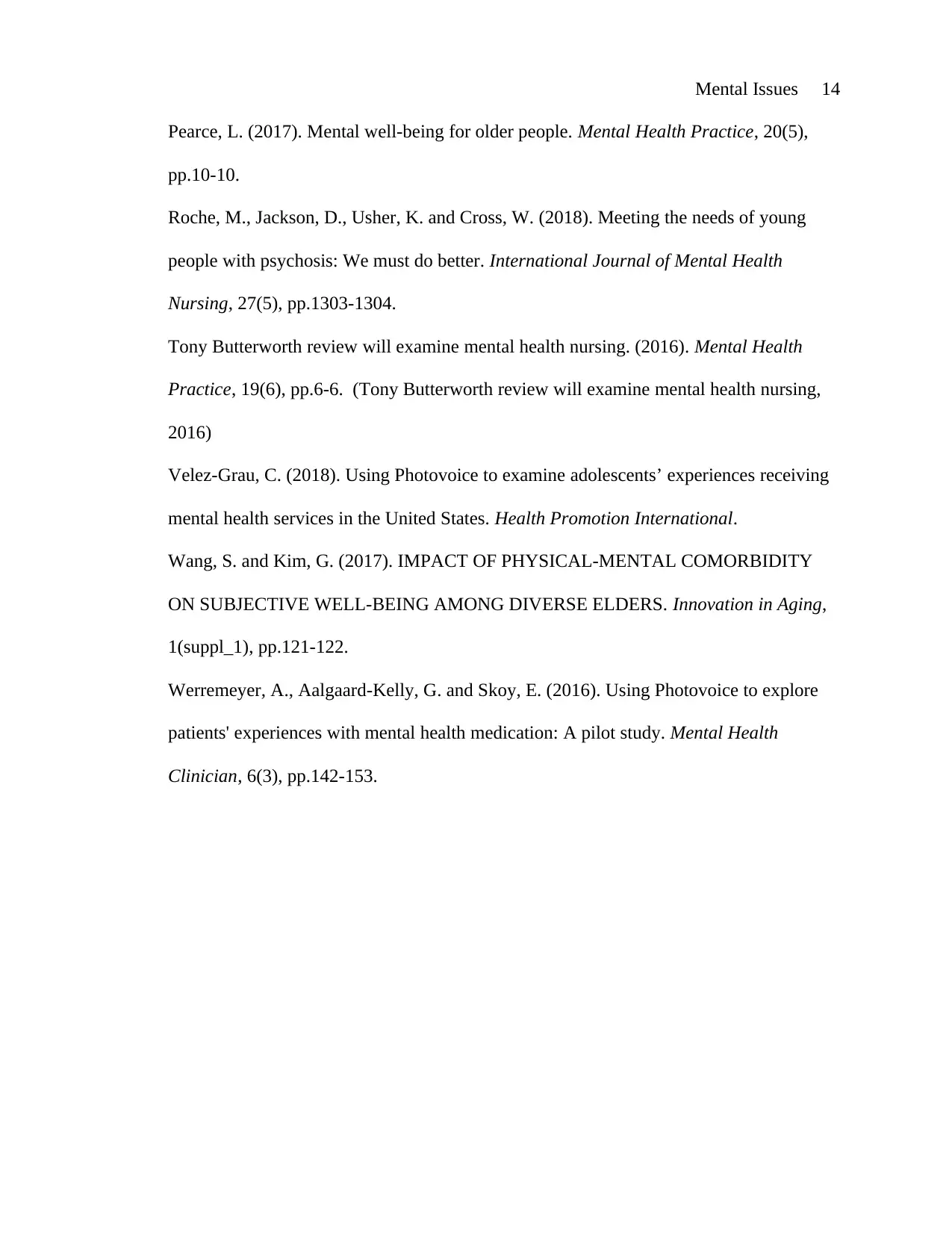
Mental Issues 14
Pearce, L. (2017). Mental well-being for older people. Mental Health Practice, 20(5),
pp.10-10.
Roche, M., Jackson, D., Usher, K. and Cross, W. (2018). Meeting the needs of young
people with psychosis: We must do better. International Journal of Mental Health
Nursing, 27(5), pp.1303-1304.
Tony Butterworth review will examine mental health nursing. (2016). Mental Health
Practice, 19(6), pp.6-6. (Tony Butterworth review will examine mental health nursing,
2016)
Velez-Grau, C. (2018). Using Photovoice to examine adolescents’ experiences receiving
mental health services in the United States. Health Promotion International.
Wang, S. and Kim, G. (2017). IMPACT OF PHYSICAL-MENTAL COMORBIDITY
ON SUBJECTIVE WELL-BEING AMONG DIVERSE ELDERS. Innovation in Aging,
1(suppl_1), pp.121-122.
Werremeyer, A., Aalgaard-Kelly, G. and Skoy, E. (2016). Using Photovoice to explore
patients' experiences with mental health medication: A pilot study. Mental Health
Clinician, 6(3), pp.142-153.
Pearce, L. (2017). Mental well-being for older people. Mental Health Practice, 20(5),
pp.10-10.
Roche, M., Jackson, D., Usher, K. and Cross, W. (2018). Meeting the needs of young
people with psychosis: We must do better. International Journal of Mental Health
Nursing, 27(5), pp.1303-1304.
Tony Butterworth review will examine mental health nursing. (2016). Mental Health
Practice, 19(6), pp.6-6. (Tony Butterworth review will examine mental health nursing,
2016)
Velez-Grau, C. (2018). Using Photovoice to examine adolescents’ experiences receiving
mental health services in the United States. Health Promotion International.
Wang, S. and Kim, G. (2017). IMPACT OF PHYSICAL-MENTAL COMORBIDITY
ON SUBJECTIVE WELL-BEING AMONG DIVERSE ELDERS. Innovation in Aging,
1(suppl_1), pp.121-122.
Werremeyer, A., Aalgaard-Kelly, G. and Skoy, E. (2016). Using Photovoice to explore
patients' experiences with mental health medication: A pilot study. Mental Health
Clinician, 6(3), pp.142-153.
1 out of 14
Related Documents
Your All-in-One AI-Powered Toolkit for Academic Success.
+13062052269
info@desklib.com
Available 24*7 on WhatsApp / Email
![[object Object]](/_next/static/media/star-bottom.7253800d.svg)
Unlock your academic potential
© 2024 | Zucol Services PVT LTD | All rights reserved.





